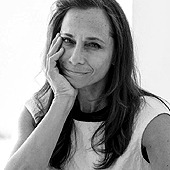
September 8, 2007
Back to School

If you stand in a certain spot in the second room of the MoMA’s gorgeous and serious new exhibition Bauhaus 1919-1933: Workshops for Modernity (opening November 8) you can see Marcel Breuer becoming modern. On axis with the entrance is his “Romantic” or “African” chair (1921) whose arcing back was woven with silk and hemp and wool by Gunta Stotzl (that’s one of her sketches above), eventual head of the weaving workshop. It seems to have more to do with folk art than modernity, but around the corner you see him transforming the crudeness of the first attempt into something more suave: the TI 1a armchair (1922), with a more refined woven wool seat, and slim legs and bent arms that slide past each other in unusual ways. Across the room, his children’s chairs and table (1923), the first with a flat board back similar to Gerrit Rietveld’s 1917 Red Blue chair, the second the original of the cubic Parsons tables made ordinary by repetition and knock-offs. All this is before 1926. His real breakthrough, the cantilever chair of bicycle tubing, is still hidden beyond another wall, sequestered with other well-known works of architecture and furniture by Breuer and Walter Gropius and Josef Albers.
That putting off of the stars, denying us the best-known objects and sticking to chronology, is a strength for this exhibit. Its underlying intent is to remind us that the Bauhaus was a school. Student work and masterpieces of modern textile art, painting, craft and industrial design are presented as part of the total package. Mies van der Rohe barely shows up until the last room, and we see his students imitating his style, but none of his own drawings. Curator Barry Bergdoll says this was an obvious choice: Mies kept his architectural commissions separate from his teaching, and the show is about the school. This has the lovely effect of reducing the well-known names to beloved profs, allowing us to better observe the hidden talents of the wider Bauhaus pool. One of my favorite cases is at the back of the last room, stocked with samples of Bauhaus upholstery fabrics by Anni Albers and Gunta Stotzl, Bauhaus wallpapers (abstract as can be) by Heinrich-Siegfried Bormann. Thewallpapers were apparently the most successful Bauhaus products. One of the cleverest textiles is practically digital, a 1932 fabric by Hajo Rose whose original sketch was typed on a typewriter, letterforms turning into repetitive and almost floral scallops.
You should go. And you should especially go on one of the days when MoMA is offering hands-on workshops. Pretend to be a first-year in Johannes Itten’s class. Learn color the Albers way. Something different is happening at MoMA when they embrace a little of the Etsy spirit.
Observed
View all
Observed
By Jessica Helfand
Related Posts

Graphic Design
Sarah Gephart|Essays
A new alphabet for a shared lived experience

Arts + Culture
Nila Rezaei|Essays
“Dear mother, I made us a seat”: a Mother’s Day tribute to the women of Iran

The Observatory
Ellen McGirt|Books
Parable of the Redesigner

Arts + Culture
Jessica Helfand|Essays
Véronique Vienne : A Remembrance
Recent Posts
Mine the $3.1T gap: Workplace gender equity is a growth imperative in an era of uncertainty A new alphabet for a shared lived experience Love Letter to a Garden and 20 years of Design Matters with Debbie Millman ‘The conscience of this country’: How filmmakers are documenting resistance in the age of censorshipRelated Posts

Graphic Design
Sarah Gephart|Essays
A new alphabet for a shared lived experience

Arts + Culture
Nila Rezaei|Essays
“Dear mother, I made us a seat”: a Mother’s Day tribute to the women of Iran

The Observatory
Ellen McGirt|Books
Parable of the Redesigner

Arts + Culture
Jessica Helfand|Essays

 Jessica Helfand, a founding editor of Design Observer, is an award-winning graphic designer and writer and a former contributing editor and columnist for Print, Communications Arts and Eye magazines. A member of the Alliance Graphique Internationale and a recent laureate of the Art Director’s Hall of Fame, Helfand received her B.A. and her M.F.A. from Yale University where she has taught since 1994.
Jessica Helfand, a founding editor of Design Observer, is an award-winning graphic designer and writer and a former contributing editor and columnist for Print, Communications Arts and Eye magazines. A member of the Alliance Graphique Internationale and a recent laureate of the Art Director’s Hall of Fame, Helfand received her B.A. and her M.F.A. from Yale University where she has taught since 1994.